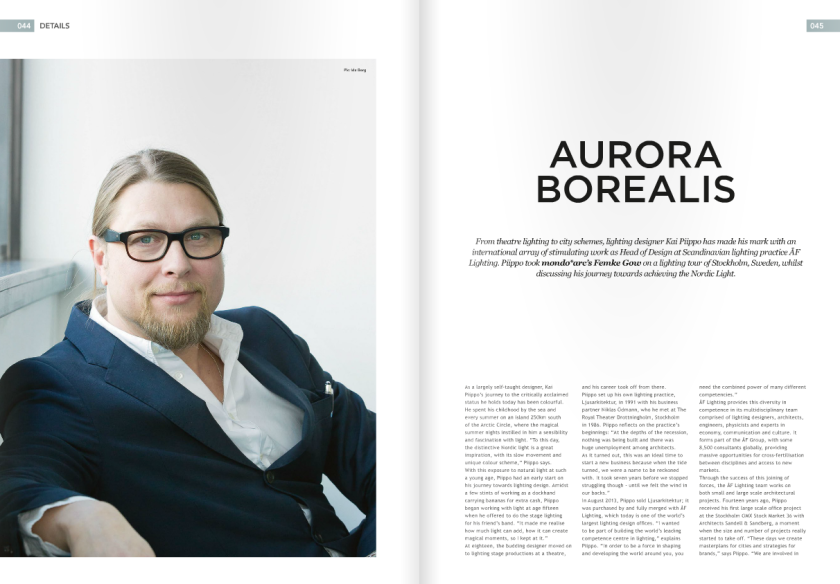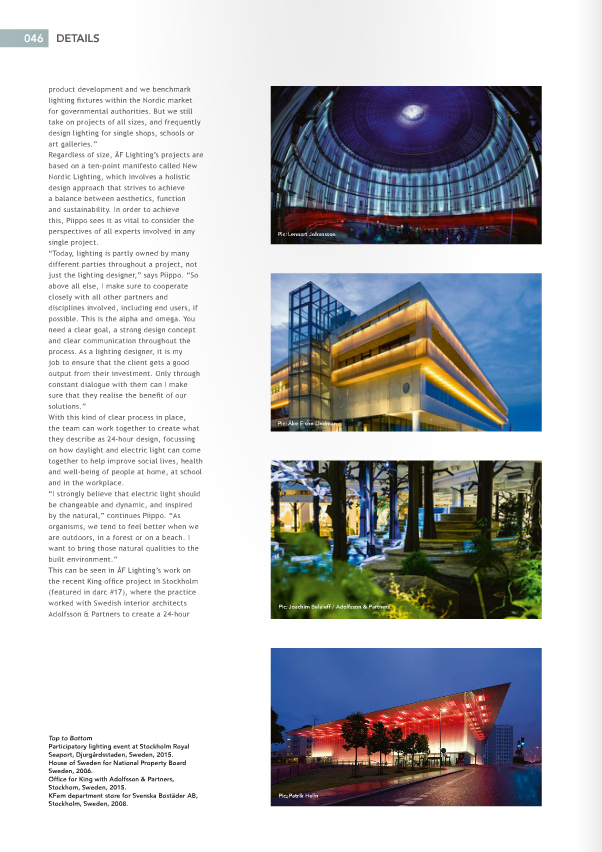 As a largely self-taught designer, Kai Piippo’s journey to the critically acclaimed status he holds today has been colourful. He spent his childhood by the sea and every summer on an island 250km south of the Arctic Circle, where the magical summer nights instilled in him a sensibility and fascination with light. “To this day, the distinctive Nordic light is a great inspiration, with its slow movement and unique colour scheme,” Piippo says.
As a largely self-taught designer, Kai Piippo’s journey to the critically acclaimed status he holds today has been colourful. He spent his childhood by the sea and every summer on an island 250km south of the Arctic Circle, where the magical summer nights instilled in him a sensibility and fascination with light. “To this day, the distinctive Nordic light is a great inspiration, with its slow movement and unique colour scheme,” Piippo says.
With this exposure to natural light at such a young age, Piippo had an early start on his journey towards lighting design. Amidst a few stints of working as a dockhand carrying bananas for extra cash, Piippo began working with light at age fifteen when he offered to do the stage lighting for his friend’s band. “It made me realise how much light can add, how it can create magical moments, so I kept at it.”
At eighteen, the budding designer moved on to lighting stage productions at a theatre, and his career took off from there.
Piippo set up his own lighting practice, Ljusarkitektur, in 1991 with his business partner Niklas Ödmann, who he met at The Royal Theater Drottningholm, Stockholm in 1986. Piippo reflects on the practice’s beginnings: “At the depths of the recession, nothing was being built and there was huge unemployment among architects. As it turned out, this was an ideal time to start a new business because when the tide turned, we were a name to be reckoned with. It took seven years before we stopped struggling though – until we felt the wind in our backs.”
In August 2013, Piippo sold Ljusarkitektur; it was purchased by and fully merged with ÅF Lighting, which today is one of the world’s largest lighting design offices. “I wanted to be part of building the world’s leading competence centre in lighting,” explains Piippo. “In order to be a force in shaping and developing the world around you, you need the combined power of many different competencies.”
ÅF Lighting provides this diversity in competence in its multidisciplinary team comprised of lighting designers, architects, engineers, physicists and experts in economy, communication and culture. It forms part of the ÅF Group, with some 8,500 consultants globally, providing massive opportunities for cross-fertilisation between disciplines and access to new markets.
Through the success of this joining of forces, the ÅF Lighting team works on both small and large scale architectural projects. Fourteen years ago, Piippo received his first large scale office project at the Stockholm OMX Stock Market 36 with Architects Sandell & Sandberg, a moment when the size and number of projects really started to take off. “These days we create masterplans for cities and strategies for brands,” says Piippo. “We are involved in product development and we benchmark lighting fixtures within the Nordic market for governmental authorities. But we still take on projects of all sizes, and frequently design lighting for single shops, schools or art galleries.”
Regardless of size, ÅF Lighting’s projects are based on a ten-point manifesto called New Nordic Lighting, which involves a holistic design approach that strives to achieve a balance between aesthetics, function and sustainability. In order to achieve this, Piippo sees it as vital to consider the perspectives of all experts involved in any single project.
“Today, lighting is partly owned by many different parties throughout a project, not just the lighting designer,” says Piippo. “So above all else, I make sure to cooperate closely with all other partners and disciplines involved, including end users, if possible. This is the alpha and omega. You need a clear goal, a strong design concept and clear communication throughout the process. As a lighting designer, it is my job to ensure that the client gets a good output from their investment. Only through constant dialogue with them can I make sure that they realise the benefit of our solutions.”
With this kind of clear process in place, the team can work together to create what they describe as 24-hour design, focussing on how daylight and electric light can come together to help improve social lives, health and well-being of people at home, at school and in the workplace.
“I strongly believe that electric light should be changeable and dynamic, and inspired by the natural,” continues Piippo. “As organisms, we tend to feel better when we are outdoors, in a forest or on a beach. I want to bring those natural qualities to the built environment.”
This can be seen in ÅF Lighting’s work on the recent King office project in Stockholm (featured in darc #17), where the practice worked with Swedish interior architects Adolfsson & Partners to create a 24-hour approach to lighting design that incorporates the qualities of both natural and electric lighting for the game creators of Candy Crush.
“Light is the strongest link between humans and architecture,” Piippo states in the ten-point manifesto. “Daylight used to play a major part in architecture and built environments, and I want to bring this back. For me, it is the basis of every project, and we always start by carrying out a daylight analysis. The electric light is then designed and controlled according to the local daylight conditions.”
The King project is one in particular to which this statement rings true; its integration of an atrium skylight lets natural light flood through to an interactive forest, where the lighting design reflects the changing seasons at the touch of a button.
This is exactly the kind of marriage of technology and design that is central to ÅF Lighting’s work, and remains at the core of developments within the industry over the years. “I personally believe that design should influence technology – not the other way around. New technology itself has no value unless you find a useful application for it, one that creates value for human beings.”

In general, Piippo finds the profession of lighting design to have matured along with the market, with many municipalities giving increasing recognition to the importance and impact of lighting by organising themselves accordingly with groups and boards for lighting issues. “Some even have a lighting specialist on the payroll,” adds Piippo.
The use of light as a branding tool is also becoming increasingly wide spread. “Look at stadiums, or areas in cities worldwide, who work specifically with lighting design to boost night time economy. In the future, this will spread even further. Whole cities will work with lighting, companies will work with office concepts and universities with campus areas.”
In the academic field, great strides have also been made in understanding how light affects human health. “There is a lot more to be found out, and this is something I would really like to be part of, both in terms of conducting more research and in applying the findings in the real world.”
With such developments in recent years, Piippo holds a positive vision for how he sees his practice and the world of lighting design growing in the future. “Six years ago, ÅF Lighting had only a handful of employees. Now there are 80 of us. Our ambitions are high: we want to have an impact on society as a whole, by cooperating with all parties involved in the built environment, and by influencing politicians and the media. Personally, I would like to pave the way for the new generation of lighting designers by creating a great creative climate within ÅF Lighting.”
Piippo sees lighting design as a self-growing business. The demand and the need for good lighting design has increased and will continue to do so. “The more we add, the more people come to realise the potential of good lighting design. I hope that through our work, we are paving the way for a new generation of professionals, to some extent.”
Despite such developments across many areas, Piippo maintains that lighting designers are not yet fully recognised as a necessity, and certainly not as much as they will be in the future. “Having worked in this field for 30 years, I can safely say that good lighting design adds value, saves costs and creates a better, more sustainable world.”
As recognition and understanding of the importance of lighting design grows, lighting designers will gradually be regarded as a necessity, and they will participate not just in a small percentage of all projects but in 100% of them. Architecture and light will blend together as professions, and the New Nordic Lighting may be given the opportunity to shine as the aurora borealis of architectural lighting.
http://issuu.com/mondiale/docs/arc92_issuu/55?e=7529423/38010339
